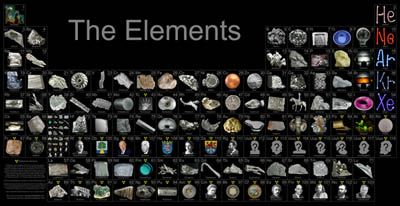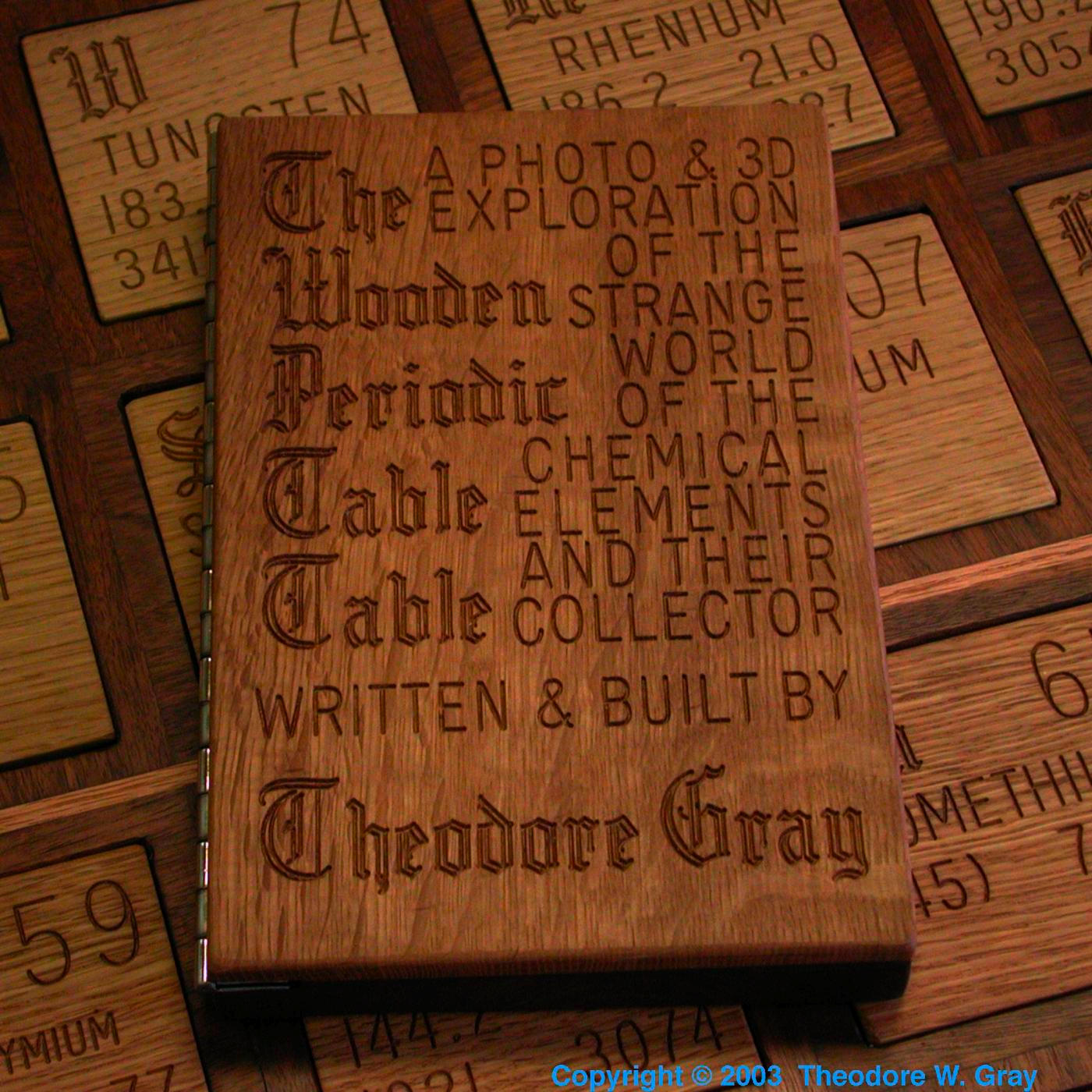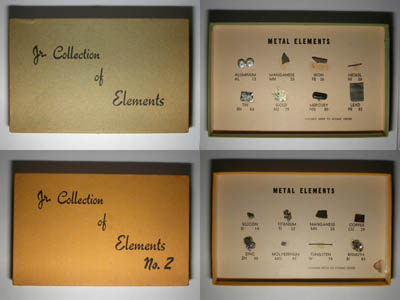|
|
|
|
|
|
|
|
|
|
|
|
|
|
|
|
|
Molybdenum steel (an alloy of iron with a few percent of molybdenum) is used extensively for machine tool bits, because it is very hard and tough. Pure, or reasonably pure (90+%), molybdenum is used for very high temperature, high pressure chemical processing equipment, because molybdenum retains great strength at high temperatures, and is impervious to many forms of chemical attack.
|
|
| |
|
|
|
|
|
Small rectangle of foil 99.95%.
Kindly donated by David Franco, who sent many elements after seeing the slashdot discussion.
Source: David Franco
Contributor: David Franco
Acquired: 17 May, 2002
Price: Donated
Size: 1"
Purity: 99.95%
|
|
|
|
|
|
|
  Cylinder. Cylinder.
Purchased from Neil Lipson (Lipson@postoffice.att.net) after contact through eBay. No information on the source or use of this sample. This stuff is close to the density of lead, but much harder. It's a nice hunk.
Analysis by x-ray fluorescence spectroscopy at the Center for Microanalysis of Materials, University of Illinois (partially supported by the U.S. Department of Energy under grant DEFG02-91-ER45439) indicates that it is essentially pure molybdenum.
I chose this sample to represent its element in my Photographic Periodic Table Poster. The sample photograph includes text exactly as it appears in the poster, which you are encouraged to buy a copy of.

Source: Neil Lipson
Contributor: Theodore Gray
Acquired: 29 May, 2002
Text Updated: 4 May, 2007
Price: $19
Size: 2"
Purity: 99.9%
|
|
|
|
|
|
|
  Nut and bolt, broken. Nut and bolt, broken.
Purchased from Neil Lipson through eBay. This bolt was said to have been from a high-temperature pressure vessel of some sort. If you look at the broken surface in the high-resolution picture, you can clearly see that it's not like any steel, at least not like any I've ever seen. The melting point of molybdenum is a good 1000C higher than steel, and it's pretty strong stuff.
Analysis by x-ray fluorescence spectroscopy at the Center for Microanalysis of Materials, University of Illinois (partially supported by the U.S. Department of Energy under grant DEFG02-91-ER45439) indicates that this bolt is approximately 92% molybdenum with the remainder a mixture of cobalt and chromium.
So, in case you had any lingering doubts about whether someone would pay $13 for a broken 1/4-20 bolt on eBay, the answer is yes.
Source: Neil Lipson
Contributor: Theodore Gray
Acquired: 15 August, 2002
Price: $13
Size: 1.5"
Purity: 92%
|
|
|
|
|
|
|
Tiny cylinder.
Ed bought half a dozen different tiny metal cylinders from David Franco, intending to make some kind of puzzle out of them (Ed's a puzzle person). But they turned out to be too irregular, so he donated them to the table.
Source: David Franco
Contributor: Ed Pegg Jr
Acquired: 19 August, 2002
Text Updated: 11 August, 2007
Price: Donated
Size: 0.2"
Purity: 99.98%
|
|
|
|
|
|
|
Sample from the RGB Set.
The Red Green and Blue company in England sells a very nice element collection in several versions. Max Whitby, the director of the company, very kindly donated a complete set to the periodic table table.
To learn more about the set you can visit my page about element collecting for a general description or the company's website which includes many photographs and pricing details. I have two photographs of each sample from the set: One taken by me and one from the company. You can see photographs of all the samples displayed in a periodic table format: my pictures or their pictures. Or you can see both side-by-side with bigger pictures in numerical order.
The picture on the left was taken by me. Here is the company's version (there is some variation between sets, so the pictures sometimes show different variations of the samples):

Source: Max Whitby of RGB
Contributor: Max Whitby of RGB
Acquired: 25 January, 2003
Text Updated: 11 August, 2007
Price: Donated
Size: 0.2"
Purity: 99.9%
|
|
|
|
|
|
|
Sample from the Everest Set.
Up until the early 1990's a company in Russia sold a periodic table collection with element samples. At some point their American distributor sold off the remaining stock to a man who is now selling them on eBay. The samples (except gases) weigh about 0.25 grams each, and the whole set comes in a very nice wooden box with a printed periodic table in the lid.
To learn more about the set you can visit my page about element collecting for a general description and information about how to buy one, or you can see photographs of all the samples from the set displayed on my website in a periodic table layout or with bigger pictures in numerical order.
Source: Rob Accurso
Contributor: Rob Accurso
Acquired: 7 February, 2003
Text Updated: 29 January, 2009
Price: Donated
Size: 0.2"
Purity: >99%
|
|
|
|
|
|
|
 Sample from Wooden Book. Sample from Wooden Book.
Max Whitby and I talked about publishing a wooden book/CD/DVD/mini element collection, but it didn't go anywhere. It would have consisted of a nicely engraved wooden "book" with a CD and DVD version of the website (for those with slower internet connections), and a set of nine safe, interesting elements in the form of cylinders, cast blocks, nodules, and the like. Think of it sort of like a mineral collection, except it's an element collection and it comes in a much nicer box. Here are a couple of pictures of the prototype:
 
This cylinder is one of the samples that we plan to include in the product.
Source: Max Whitby of RGB
Contributor: Max Whitby of RGB
Acquired: 12 May, 2003
Text Updated: 11 August, 2007
Price: Donated
Size: 0.5"
Purity: 99.9%
|
|
|
|
|
|
|
 Molybdenum mirror. Molybdenum mirror.
I have no idea what these things are for, but they seem to be associated with some kind of laser application. They are tiny, less than 1/4" long overall. The box says they are 1/4 wave mirrors, which means the surface is certified to be flat to within 1/4 of the wavelength of the light they are intended to be used with, about 10 microns in the deep infrared.
A claim I find to be somewhat dubious. I mean, just look at the things: Do they look like mirrors to you? Any part of them? If you know anything about these devices, I'd like to hear about it.
Source: eBay seller vanagon
Contributor: Theodore Gray
Acquired: 1 August, 2003
Price: $10
Size: 0.20"
Purity: 99%
|
|
|
|
|
|
|
Molybdenum powder.
Why do I get myself into these things? 30 pounds of molybdenum powder? This is a five pound bottle, but I've got six of them. Lord knows what I was thinking. Anyway, I'm going to try fusing some of the powder in my arc furnace, just to see if it can be done.
Source: eBay seller 5kumar
Contributor: Theodore Gray
Acquired: 23 September, 2003
Price: $90
Size: 8"
Purity: 99%
Sample Group: Powders
|
|
|
|
|
|
|
Molybdenum powder pen.
Unfortunately, unless they changed their name, this pen is not from the same company that made the 30 pounds of molybdenum powder I have (see above). But it was obviously made (probably in the 50s judging from the condition) by someone with a great passion for molybdenum powder. It's an ordinary pen, but sealed in a little capsule is a little bit of what I can only assume is in fact molybdenum powder.
Should you worry about your kid chewing on a molybdenum powder pen? Although my bottles of molybdenum powder (see above) have dire health warnings on them, molybdenum is actually one of the less toxic metals, even in powdered form. The consequences of eating this pen would probably be minimal, largely limited to wondering why on earth you let you kid get into your element collection in the first place, and a sense of relief that they found this one instead of the uranium ore powder pen.
Source: eBay seller oldboytoyz
Contributor: Theodore Gray
Acquired: 9 November, 2003
Price: $18.50
Size: 6"
Purity: 99%
Sample Group: Powders
|
|
|
|
|
|
|
Mini element collection.
This is a nice little set from the 1960's. The enclosed price list indicates it cost a few dollars, and the enclosed mercury sample indicates it predates current environmental concerns! Here's a picture of the whole 2-box set:

Source: Blake Ferris
Contributor: Theodore Gray
Acquired: 15 July, 2004
Price: $61/set
Size: 1"
Purity: >98%
|
|
|
|
|
|
|
  High purity button. High purity button.
This very high purity button was produced by Kaistar R&D (see Source link below if you want one) in their vacuum electron beam furnace, which Oliver Sacks and I visited in the summer of 2004. I wrote a story about the visit, which includes photographs of the incredible furnace used to produce this button and the many others they offer on eBay and direct to the element collecting hobby. I think it's safe to say that you will not find more perfect samples of transition metals anywhere.
This sort of button is hard to appreciate in a photograph: It's the great smoothness and density that make them so satisfying to hold.
Source: Kaistar R&D
Contributor: Kaistar R&D
Acquired: 6 August, 2004
Price: Donated
Size: 0.75"
Purity: 99.995%
|
|
|
|
|
|
|
|
|
|
  Element coin. Element coin.
Dave Hamric sells element samples under the name Metallium. He's developed a line of coins struck out of various common and uncommon metals: They are quite lovely, and very reasonably priced, considering the difficulty of creating some of them.
Here is the back side of this coin (click either picture to see it larger):

Click the Sample Group link below to see many other coins made of various elements, or click the link to his website above if you want to buy one like this.
Source: Dave Hamric
Contributor: Theodore Gray
Acquired: 1 December, 2006
Text Updated: 14 January, 2007
Price: $14
Size: 0.75"
Purity: >99%
Sample Group: Coins
|
|
|
|
|
|
|
|
|
|
  Molybdenum commemorative medallion. Molybdenum commemorative medallion.
From the eBay seller's listing:These pure molybdenum coins are the only 1 ounce molybdenum coins in the world ( as far as I know). They have been hand cut from .9995 pure molybdenum rod ( certificate with coin giving complete analysis) , hand polished and then deburred and stamped using special steel for the dies. The minting is of the highest quality. The coins weigh over 1 ounce each with some small variation because they are hand cut. Wow, what an odd way to make coin blanks, normally they are stamped from sheet, not cut from a rod. This may explain the oddly mottled surface texture.
Source: eBay seller silverspoon53
Contributor: Theodore Gray
Acquired: 28 February, 2009
Text Updated: 1 March, 2009
Price: $50
Size: 1.5"
Purity: 99%
|
|
|
|
|
|
|
|
|
|
|
|
|
  Molybdenum nut. Molybdenum nut.
Purchased from Neil Lipson through eBay. This bolt was said to have been from a high-temperature pressure vessel of some sort.
Analysis by x-ray fluorescence spectroscopy at the Center for Microanalysis of Materials, University of Illinois (partially supported by the U.S. Department of Energy under grant DEFG02-91-ER45439) indicates that this bolt is approximately 92% molybdenum with the remainder a mixture of cobalt and chromium.
Source: Neil Lipson
Contributor: Theodore Gray
Acquired: 25 April, 2009
Text Updated: 25 April, 2009
Price: $13
Size: 0.4"
Purity: 92%
|
|
|
|
|
|
|
|
|
|
  Wolfenite. Wolfenite.
I'm not sure why I have this mineral: I think it may have been a free sample included with some other mineral purchase. In any case, it's quite lovely, and unusual in chemical composition: Lead and molybdenum.
Source: eBay
Contributor: Theodore Gray
Acquired: 15 October, 2005
Price: Donated
Size: 0.25"
Composition: Pb(MoO4)
|
|
|
|
|
|
|
  Molybdenite. Molybdenite.
Description from the source:
Molybdenite (Mo S2 hex.), Getchell Mine, Humboldt Co., Nevada, USA. Lustrous crystals on matrix with Epidote. 6,5x4,5x3 cm; 105 g.
Source: Simone Citon
Contributor: John Gray
Acquired: 30 September, 2008
Text Updated: 1 October, 2008
Price: Trade
Size: 2.5"
Composition: MoS2
|
|
|
|
|
|
|
  Wulfenite. Wulfenite.
Description from the source:
Wulfenite (Pb Mo O4 tet.), Red Cloud Mine, Arizona, USA. Perfect crystal. 1,3x1,2x0,4 cm; 10 g with box.
Source: Simone Citon
Contributor: John Gray
Acquired: 26 October, 2008
Text Updated: 26 October, 2008
Price: Trade
Size: 0.5"
Composition: PbMoO4
|
|
|
|
|
|
|
|
|
|
  Molybdenum trioxide crystals. Molybdenum trioxide crystals.
These are lovely transparent crystals of molybdenum trioxide which I made myself using nothing more than an acetylene welding torch and a molybdenum plate. Lovely. Just lovely. Too bad I was trying to make diamonds, not molybdenum trioxide. It seems that blowing an ordinary acetylene torch at a molydenum or silicon plate held at the right temperature will cause a thin film of diamond to form slowly on the surface. After my first attempt at this I saw a few tiny flakes of what was unmistably transparent crystal material. Needless to say I was pretty excited by this. Unfortunately, when I continued the experiment I started getting lots and LOTS of this beautiful crystal material, so much that it could not possibly be diamond, since what was expected was a few microns of polycrystalline film, not macroscopic crystals like these. Sadly, it is simply molydenum trioxide, a species that forms in air at high enough temperatures.
I'm still working on the diamond making, it will be a Popular Science column if I get it to work.
Source: Theodore Gray
Contributor: Theodore Gray
Acquired: 27 December, 2008
Text Updated: 28 December, 2008
Price: Free
Size: 1"
Composition: MoO3
|
|
|
|
|
|
|
|
|
|
  M42 molybdenum cobalt steel bit. M42 molybdenum cobalt steel bit.
A typical fairly large milling machine bit called an end mill. It is made of M42 molybdenum-cobalt steel allow, often called cobalt steel because even though it has more molybdenum than cobalt in it, it is an alloy distinguished by its cobalt content being higher than that in most others steels.
Source: eBay seller aztool-jerry
Contributor: Theodore Gray
Acquired: 11 March, 2009
Text Updated: 12 March, 2009
Price: $15
Size: 4"
Composition: FeMoCo
|
|
|
|
|
|
|
|
|
|
|
|
|
|
|
|
|
|